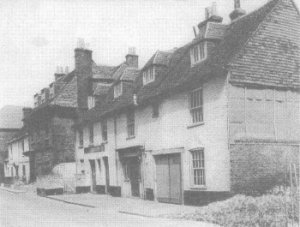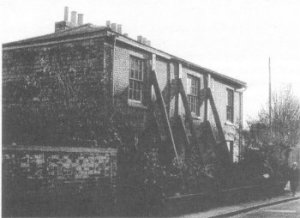Winchester Preservation Trust, 1957-1995 - TrustNews Spring 1996
Jeffery Smith, a Founder Member and past Chairman of the Trust and of the Heritage Centre Management Committee, recalls the beginnings and development of the Trust.
This very brief history of the Trust deals with a period of some 40 years, and much has happened in that time. It is not possible to mention all the many dedicated supporters of the Trust during that period, and mention therefore will only be made of one, that of Dr Tremellen, first Chairman and generous patron. The Trust came to being in her house in St Giles Hill in 1957. From that beginning events moved very quickly, and at our first AGM on 27 November 1958, membership of the Trust had already reached 170.
These were troubled times. Winchester was undergoing a drastic change, when over five hundred of the older houses in the centre of the city were faced with demolition. However although the immediate task of the newly-formed Trust was preservation, the first annual report stressed that the Trust was taking an active interest in all matters affecting the character of Winchester, and in fact continues to do so.

Canon Street 1960 - threatened with demolition
(photograph by courtesy of A.E. Sollar)
In terms of achievement, areas of Winchester can be pointed out which would no longer exist but for the action of the Trust. Canon Street is perhaps the most notable example. The Trust opposed every clearance order, and members purchased houses from the City Council to protect them from demolition. The top north side of Canon Street was actually demolished, but the Trust ensured that the resulting rebuilding was done to a suitable scale and standard. Another example of the actions of the Trust was the preservation of St Peter's Chesil Church where the cost of repair was met by a Fine Art's auction organised by the Trust. The silhouette of St Peter's Chesil Church is now incorporated into the Trust's logo. And more recently much of St John's Street was eventually saved by co-operation between the Winchester Preservation Trust and the Hampshire Buildings Preservation Trust.
However much was also lost. Five hundred houses were demolished and their sites remained undeveloped for many years. Important listed houses in Upper Brook Street went, as did also the Old Hospital in Colebrook Street. Many little Georgian and Victorian houses in the Brooks area disappeared, including the Flint houses in Middle Brook Street.

Nos. 2, 4 & 6a Upper Brook Street, Winchester. The middle building
dates from about 1690, and was the home of the Mayors of
Winchester, during part of the 18th century
The Trust could do little to prevent this destruction, but every clearance and demolition order was vigorously opposed. Although it could be said that the Trust was formed specifically to save the listed buildings in Upper Brook Street, no's 2, 4 and 6a and much time and effort went into this, in retrospect the City Council had already obtained a special Act of Parliament to widen St George's Street and construct the Brooks Car Park. It is interesting to note however, that if Trust had been successful, the Brooks Shopping Centre would never have been constructed, and Winchester would not have lost 2000 years of archaeology.
Following Local Government reorganisation, the boundaries of Winchester extended as far as Hamble. The interests of the Trust however remained within the boundaries of Winchester City, but added responsibilities were acquired particularly with regard to planning, where every application is monitored by teams of professional and lay members of the Trust. The Trust has also been active in obtaining the listing of buildings omitted from the original lists, and two notable examples are the White Swan in Hyde Street, and the Rising Sun in Morn Hill.

Flint houses, Middle Brook Street
One of the most important developments in the history of the Trust was the acquisition of the Heritage Centre in Middle Brook Street. In 1978 this building consisted of two small Georgian houses dating from 1820. The City was anxious to demolish them so that the site could be added to the car park, but they were deemed worthy of preservation, and permission to demolish was refused after an Inquiry. By this time the property had become derelict with the front walls shored up, many of the roof slates missing, and the doors and windows boarded up. The Trust however realised its potential and applied for a licence from the Council to use it as a Heritage Centre. Faced with heavy expenditure members gave both money and labour to make it habitable. Following genČerous grants from the County Council and the Carnegie Trust, the two houses were converted into one and the Centre became much as it is today. It is interesting to note that the original planning consent was for the Trust's Headquarters and Urban Studies Centre. Finally the Heritage Centre acquired listed status, which did much to secure its future, and also to control the surrounding development. Of the many Civic Societies in the South of England which meet together once a year, Winchester Preservation Trust is the only Society which has its own Heritage Centre, and it also has one of the highest memberships. Its importance as the Trust's Headquarters can best be realised by those members of the committee who previously had to meet in many different places throughout the City.

The Old Hospital, Colebrook Street, in course of demolition
It is difficult in this short history to describe all the Trust's activities, but mention should be made of the Chippindale Venture which has successfully brought an appreciation of Winchester to the school children of the area. Another development was the Trust's interest in all matters relating to traffic which prevented the dual carriageway inner ring road and helped initiate the policy of Park & Ride. The Westgate has always been a concern of the Trust: when the buildings on the north side of the Gate were removed, it became isolated, and, with the whole area around it paved, lost even the appearance of its original function as an entrance to the City. The Trust has been successful in helping improve the situation with special paving under the arch, and is hopeful that more will be done in the near future.
Other current concerns include the redevelopment of Peninsula Barracks where the Trust contributed ú2500 and much effort to ensure adoption of the conservation scheme, and continues to monitor its progress with care. The Trust is interested in the buried kitchens of Charles II's Palace, although this must necessarily be a longer-term project.
Recently the Heritage Centre was nearly lost due to a change in City policy, but should now continue to be a major interest to the Trust. Its role as an Urban Studies Centre is already of great importance, but could be enhanced by proposals to add the model room and photographic archive service. Exhibitions of local interest are held at the centre, a recent example being the reconstruction of Hyde Abbey, the burial place of King Alfred. For visitors there is a video presentation of the history of Winchester, and pictorial displays of such events as the mediaeval fair at St Giles Hill and the siege of Winchester Castle. It is well worth a visit.

The Heritage Centre in 1978
(photograph by courtesy of Hampshire Chronicle)
